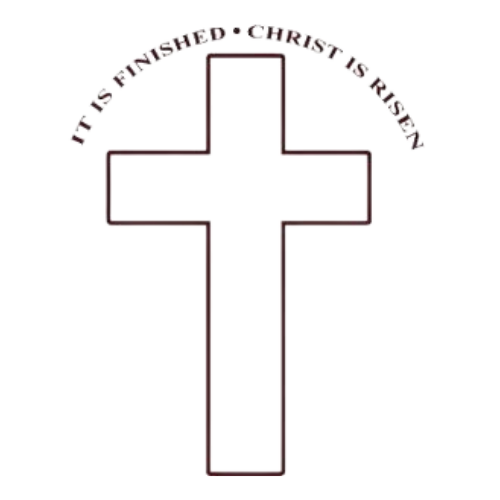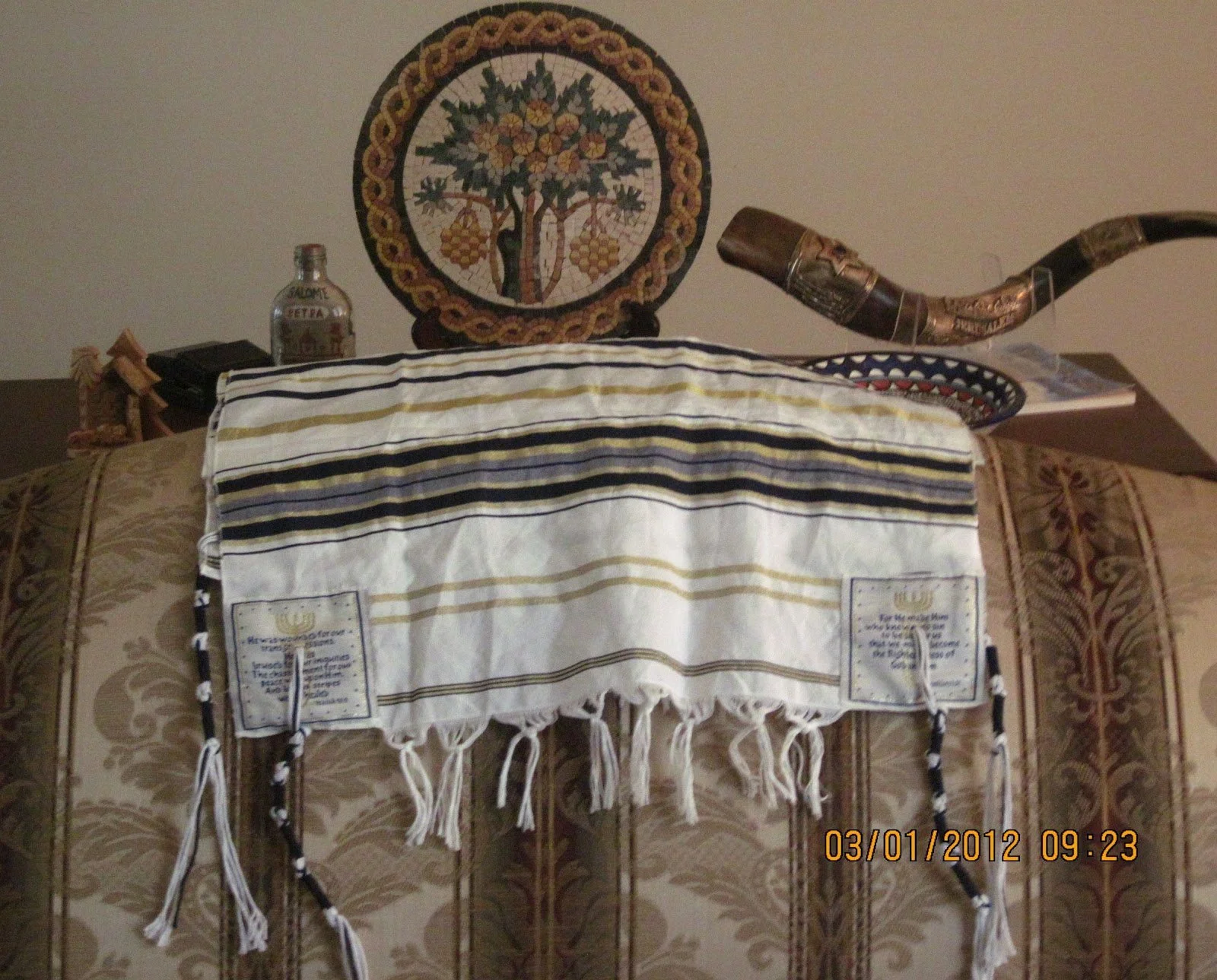THE TALLIT
THE TALLIT or prayer shawl: In the Old Testament, God gave the twelve tribes of Israel (the House of Jacob or Israel) specific instructions as to how they should design and wear their priestly attire as they escaped the bondage of Egypt.
From this idea the religious prayer shawl is made and used.
“Tallit” simply means gown or cloak, reflecting the fact that it was originally worn throughout the day. It probably resembled the abbayah (blanket) still worn by Bedouins. The word tallit isn’t originally Hebrew and does not appear in the Bible; rather, other words meaning robe or garment are paired with words meaning tassel or fringe to indicate the proper attire.
Many rabbinic authorities, however, favor a simple tallit of pure white wool as the classic Biblical garment, basing themselves on the verse “let your garments always be white” (Ecclesiastes 9:8). The tzitzit (threads or fringes) attached to each corner are traditionally made of the same fabric as the tallit; however, wool fringes are always permissible.
These tassels in Hebrew is called “tzitzit” (singular) pronounced “seet-seet.” In the King James Version of the Bible they are translated as “fringe” or “fringes.” These fringes are attached to the “borders” or “corners” of their garments, or tallit.
The KJV translates the Hebrew word “kanaph” as “borders” in Numbers 15:38. According to the Brown Driver-Briggs’ Hebrew dictionary the Hebrew word “Kanaph” means:
1) wing, extremity, edge, winged, border, corner, or skirt.
The earliest mention of Kanaph is found in Exodus 19:4 : “You have seen what I did unto the Egyptians, and how I bare you on eagles’ wings (kanaph), and brought you unto myself.”
Many Bible teachers have stated that the first use of a word sets the stage for the underlying meaning of the word throughout the remainder of the Scriptures.They call this the “law of first reference.” Here we can concur that through the “kanaph” there is deliverance. The children of Israel were delivered or set free from the Egyptians because God bare them on 'eagles' kanaph, and brought them unto Himself.
The wearing of the “tallit” (pronounced tal-eet), also called the “tallis” or “prayer shawl,” was commanded by God.
In Deuteronomy 22 :12 and Numbers 15:37-40; “Speak unto the children of Israel (the twelve tribes), and bid them that they make them fringes in the borders of their garments throughout their generations…and it shall be unto you for a fringe, that you may look upon it, and remember all the commandments of the Lord.”
In Numbers 15:38 the word translated border or corner is a Hebrew word which can also be translated wings and appears seventy-six times in the Biblical text.
For this reason, the corners of the prayer shawl are often called wings. Each tzitzit consists of five double knots and eight threads, a total of thirteen elements. This number added to six hundred, the Hebraic numerical value of the word tzitzit points to the six hundred and thirteen commandments of the Law otherwise called the pentateuch or Torah.
As the Tallit was placed over the head, it formed its own tent. WINGS of the garment were formed when the arms were held out. For this reason, the corners of the prayer shawl are often called “wings.”
During the first century there were several traditions associated with the tzitzit concerning Messiah. One was that these knotted fringes possessed healing powers. Certainly the woman with the issue of blood knew of these traditions, which would explain why she sought to touch the hem (the wings) of Jesus’ prayer garment. The same word used in Numbers 15:38 for corner is used in Malachi 4:2 for wings. "But for you who revere my name the sun of righteousness shall rise, with healing in its wings." (Mal. 4:2).
TAL-ITH contains two Hebrew words; TAL meaning tent and ITH meaning little. Thus, you have LITTLE TENT.
The prayer Shawl makes it possible for each person to have his/her own little tent to pull up over his/her head, forming a tent, thus having his/her own prayer closet!
The Tallit used as a Status Symbol:
The people of other nearby nations also had this custom. In texts found in Mesopotamia, references indicate that the removal of the fringe of a man’s garment was the equivalent of removing part of his personality. To cut off the hem of a wife’s garment was regarded as divorcing her. Tablets have been found with the impression of a fringe as the mark of the individual, a personal seal or signature.
In New Testament times, ordinary people only wore a tallit on special occasions, if at all. It was the Pharisees who seem to have worn it regularly and, apparently in some cases, often for show. Jesus expresses no disapproval of the custom itself but he does condemn the extra long fringes that they affected to display their piety (Matthew 23:5).
Saul, Samuel and David:
“And Samuel said unto Saul, I will not return with you: for you have rejected the word of the Lord, and the Lord has rejected you from being king over Israel. And as Samuel turned about to go away, he laid hold upon the skirt (kanaph) of his mantle (tallit), and it rent. And Samuel said unto him, The Lord has rent the kingdom of Israel from you this day, and has given it to a neighbor of yours, that is better than you.” 1 Samuel 15:26–28
Saul, after disobeying God, was told by Samuel that his kingship was over. Pleading with Samuel, Saul rips the tzitzit out of Samuel’s tallit, which becomes a symbolic picture of Saul’s kingdom being ripped from him. The reason Saul lost his authority was because he was no longer a symbol of authority.
There is another history that goes along with the tallit. Remember when David was being chased by Saul, and he didn’t have as many men as Saul, but Saul was determined to kill David. Basically, Saul was over on this side of the hill and there was a ravine and he was with his men and there was a cave, and Saul went into the cave into the inner recesses of the cave to sleep. Saul was guarded by all his men. During the night David sneaks over the ravine and instead of killing Saul he cuts the edge of his garment, and took the tzizit. The next day David stood on the other side of the hill, the mountain with the ravine and called out to Saul. Saul began telling David how much he is going to kill him, and David basically said to Saul, “Saul, look at your garment. I could have killed you, but I tried to respect your authority, so look at this tassel in my hand, I have it as a symbol of your authority and one of yours is missing”
Resource: Messiah ministry

